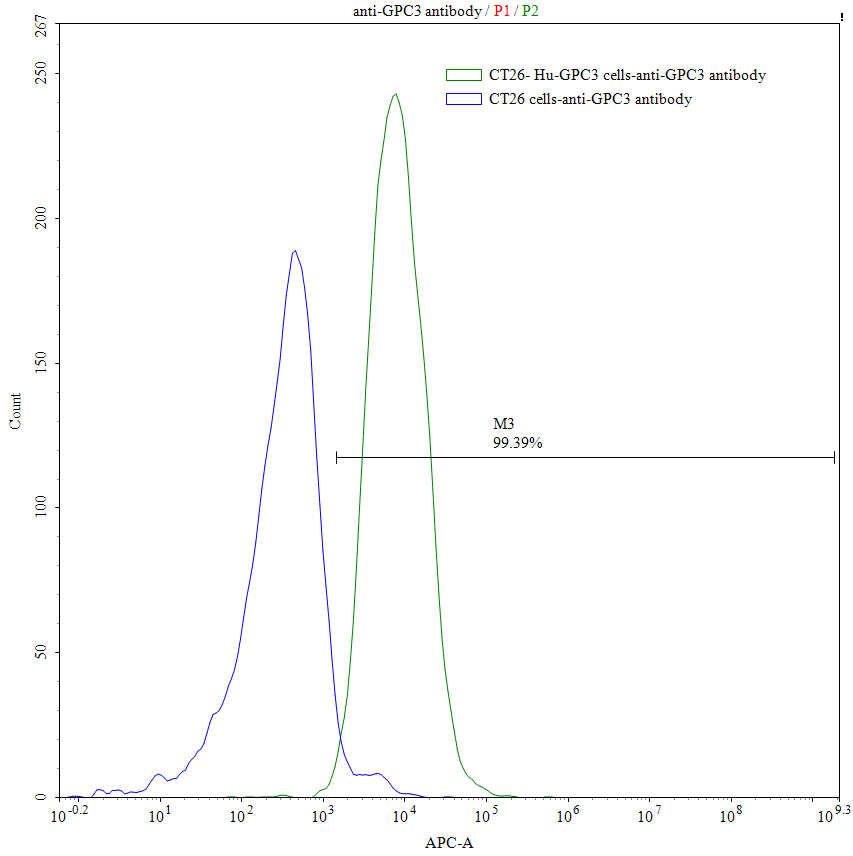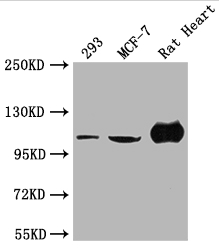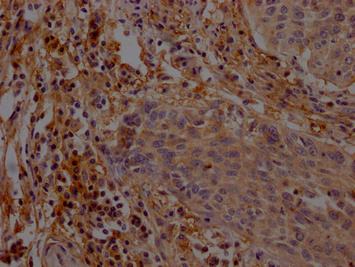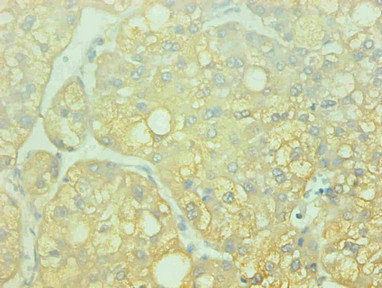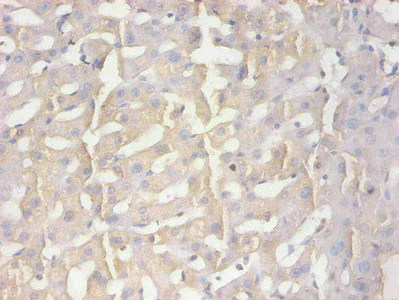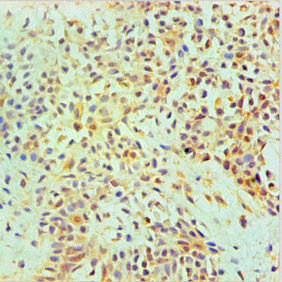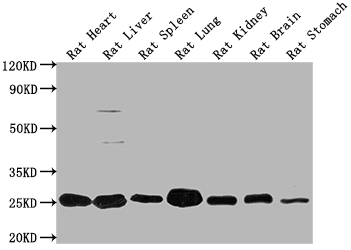CT26/Human GPC3 Stable Cell Line
-
货号:CSB-SC009705HU2
-
规格:1 vial contains approximately 5x106 cells in 1 ml
-
价格:¥30000
-
活性:
-
其他:
产品详情
-
Uniprot No.:
-
生长类型:Adherent
-
抗性:Puromycin
-
培养基:DMEM + 10% FBS + 10μg/mL Puromycin
-
别名:GPC3
-
蛋白标签:Tag-Free
-
保存缓冲液:35% FBS + 55% DMEM + 10% DMSO
-
应用范围:Binding assay by FACS and cell based ELISA.
-
储存条件:Frozen in liquid nitrogen or stored at -80°C
-
货期:Basically, we can dispatch the products out in 1-3 working days after receiving your orders. Delivery time maybe differs from different purchasing way or location, please kindly consult your local distributors for specific delivery time.
相关产品
靶点详情
-
功能:Cell surface proteoglycan that bears heparan sulfate. Negatively regulates the hedgehog signaling pathway when attached via the GPI-anchor to the cell surface by competing with the hedgehog receptor PTC1 for binding to hedgehog proteins. Binding to the hedgehog protein SHH triggers internalization of the complex by endocytosis and its subsequent lysosomal degradation. Positively regulates the canonical Wnt signaling pathway by binding to the Wnt receptor Frizzled and stimulating the binding of the Frizzled receptor to Wnt ligands. Positively regulates the non-canonical Wnt signaling pathway. Binds to CD81 which decreases the availability of free CD81 for binding to the transcriptional repressor HHEX, resulting in nuclear translocation of HHEX and transcriptional repression. Inhibits the dipeptidyl peptidase activity of DPP4. Plays a role in limb patterning and skeletal development by controlling the cellular response to BMP4. Modulates the effects of growth factors BMP2, BMP7 and FGF7 on renal branching morphogenesis. Required for coronary vascular development. Plays a role in regulating cell movements during gastrulation.
-
基因功能参考文献:
- The areas under the receiver operating curve (AUROC) value, sensitivity and specificity of glypican 3 (GPC3) for hepatoblastoma (HB) pretreatment group versus all controls were all significantly lower than those of alpha-fetoprotein (AFP). PMID: 28378832
- GPC3 is operating through an intricate molecular signaling network. From the balance of these interactions, the inhibition of breast metastatic spread induced by GPC3 emerges. PMID: 30267212
- Its surface is modified with anti-GPC3 antibody. PMID: 29916268
- data suggest that transcriptionally targeted delivery of transgene in HCC cells can be achieved using the GPC3 promoter and this targeting strategy produces limited toxicity to normal liver cells PMID: 29563582
- High GPC3 expression is associated with Hepatocellular Carcinoma. PMID: 28429175
- Study demonstrated that GPC3 expression is inversely associated with glucose metabolism, suggesting that GPC3 may play a role in regulating glucose metabolism in hepatocellular carcinoma. PMID: 29398870
- the intravenous injection of SF-PL/siGPC3 into nude mice bearing subcutaneous human HepG2 xenografts effectively inhibited tumor growth and also increased the survival rates of animals. These results revealed the great potential of the PEI-modified liposomal nanomedicine carrying SF and siGPC3 to improve Hepatocellular carcinomatreatment PMID: 29106433
- Invasive hepatocellular carcinoma (HCC) samples and HCC cell lines with high metastatic potential exhibited higher MXR7 expression. Overexpression of MXR7 promoted epithelial-mesenchymal transition (EMT) progress, and MXR7 depletion repressed the EMT phenotype. Human MXR7 protein is a mediator of EMT and metastasis in HCC. PMID: 28812296
- Overexpression of GPC3 was significantly associated with poor prognosis in patients with hepatocellular carcinoma. PMID: 29901640
- These data show that glycanation and convertase maturation are not required for soluble mutant GPC3 to inhibit hepatocellular carcinoma cell proliferation. PMID: 29345911
- Data indicate that several microRNAs targeting the oncogenic functions of glypican-3 (GPC3). PMID: 28476031
- presence distinguishes aggressive from non-aggressive odontogenic tumors PMID: 27647326
- GPC3 as a potential metastasis suppressor gene and suggest its value as a prognostic marker in gastric cancer. PMID: 27259271
- In this study we systematically evaluated a series of CAR constructs targeting glypican-3 (GPC3), which is selectively expressed on several solid tumors. We compared GPC3-specific CARs that encoded CD3zeta (Gz) alone or with costimulatory domains derived from CD28 (G28z), 4-1BB (GBBz), or CD28 and 4-1BB (G28BBz). PMID: 27530312
- Data indicate that glypican-3 (GPC3) is an important regulator of epithelial-mesenchymal transition (EMT) in breast cancer, and a potential target for procedures against breast cancer metastasis. PMID: 27507057
- Glypican-3 overexpression in Wilms tumor correlates with poor overall survival. PMID: 28432433
- glypican-3 has a role in HBV-related hepatocellular carcinoma PMID: 27286460
- MOSPD1 is a possible candidate gene for DORV, probably in combination with GPC3. Further studies of the combined functions of MOSPD1 and GPC3 are needed, and identification of additional patients with MOSPD1 and GPC3 duplication should be pursued PMID: 28636109
- Glypican-3 is correlated with the clinical malignant behavior of hepatocellular carcinoma and its phenotype changes from positive to negative during tumor cells differentia- tion. PMID: 28087980
- The diagnostic sensitivity for hepatocellular carcinoma increased to 72.8% (206 of the 283) when glypican 3 was combined with alpha-fetoprotein. PMID: 26370140
- The lncRNA glypican 3 antisense transcript 1 (GPC3-AS1) has been reported to be a potential biomarker for hepatocellular carcinoma (HCC) screening. We observed a significant upregulation of GPC3-AS1 in HCC. Increased expression of GPC3-AS1 was associated with alpha-fetoprotein, tumor size, microvascular invasion, encapsulation, Barcelona Clinic Liver Cancer stage, and worse prognosis of HCC patients. PMID: 27573079
- study provides the first evidence that GPC3 can modulate the PCSK9 extracellular activity as a competitive binding partner to the LDLR in HepG2 cells. PMID: 27758865
- By subsequent Sanger sequencing of genomic DNA we could map the chromosomal break points to define a deletion size of 43,617 bp including exons 5 and 6 of the GPC3 gene. PMID: 28371070
- This is the first study in which the optimal HLA-A*0201 GPC3 epitopes were screened from a large number of candidates predicted by three software. The optimized HLA-A*0201 GPC3 peptides will provide new epitope candidates for hepatocellular carcinoma (HCC) immunotherapy. PMID: 27102087
- GPC3 and KRT19 overexpression are associated with carcinogenesis, progression, and poor prognosis in patients with PDAC and a valuable biomarker for diagnosis of PDAC. PMID: 27689616
- The clinical implication of GPC3 detection and targeting in the management of patients with hepatocellular carcinoma. Review. PMID: 26755876
- Glypican 3 expression showed a significant difference between endometrioid endometrial carcinoma and serous endometrial carcinoma, and it was significantly correlated with tumor grade, stage and myometrial invasion PMID: 26722522
- Data show that notum and glypican-1 and glypican-3 gene expression during colorectal cancer (CRC) development and present evidence to suggest them as potential new biomarkers of CRC pathogenesis. PMID: 26517809
- GPC3 expression was measured in hepatocellular carcinoma at different stages and correlated with prognosis. CK19+/GPC3+ HCC has the highest risk of intrahepatic metastasis, microvascular invasion, regional lymph node involvement, and distant metastasis. PMID: 26977595
- Review: Glypican-3 is a highly specific biomarker for the diagnosis of hepatocellular carcinoma and a promising therapeutic target. PMID: 26256079
- In South Korean hepatocellular carcinoma patients, GPC3 expression was more frequent in hepatocellular carcinoma with aggressive features, but it was not an independent prognostic biomarker. PMID: 26764243
- In this meta-analysis, GPC3 was found to be acceptable as a serum marker for the diagnosis of hepatocellular carcinoma. PMID: 26502856
- GPC3 may be a candidate marker for detecting lung squamous cell carcinoma. PMID: 26345955
- study suggests that GPC3 is involved in HCC cell migration and motility through HS chain-mediated cooperation with the HGF/Met pathway, showing how HS targeting has potential therapeutic implications for liver cancer PMID: 26332121
- potential role of GPC3 in urothelial carcinogenesis warrants further investigation, especially the potential use of Glypican-3 for therapeutic and diagnostic purposes PMID: 25896897
- Downregulation of glypican-3 expression increases migration, invasion, and tumorigenicity of ovarian cancer. PMID: 25967456
- GPC3 expression is an independent prognostic factor for postoperative hepatocellular carcinoma PMID: 25432695
- Identify a GPC3-specific T-cell receptor. Expression of this receptor by T cells allows them to recognize and kill GPC3-positive hepatoma cells. PMID: 26052074
- High expression of glypican-3 is associated hepatoblastoma. PMID: 25735325
- GPC3 and E-cadherin expressions are not independent prognostic factors in CRC. PMID: 25619476
- In HCC patients, sGPC3N levels were significantly increased (mean/median, 405.16/236.19 pg mL(-1) ) compared to healthy controls (p < 0.0001), and 60% of HCC cases (69/115) showed sGPC3N levels that were higher than the upper normal limit. PMID: 25784484
- GPC3 contributes to hepatocellular carcinoma progression and metastasis through impacting epithelial-mesenchymal transition of cancer cells, and the effects of GPC3 are associated with ERK activation. PMID: 25572615
- Most cases of hepatoblastoma and yolk sac tumor, and some cases of other tumors were found to express GPC3. On the other hand, GPC3 was physiologically expressed during the fetal and neoinfantile period under 1 year of age. PMID: 25344940
- OPN, SPINK1, GPC3 and KNPA2 were significantly over-expressed in HCC tissues. These genes may be useful in developing future biomarkers and therapeutic strategies for HCC PMID: 25862856
- Data indicate that zinc-fingers and homeoboxes 2 (ZHX2) suppresses glypican 3 (GPC3) transcription by binding with its core promoter. PMID: 25195714
- propose that the structural changes generated by the lack of cleavage determine a change in the sulfation of the HS chains and that these hypersulfated chains mediate the interaction of the mutant GPC3 with Ptc PMID: 25653284
- GPC3 is associated with the HCC cell biological behavior. PMID: 25270552
- Data indicate that the triple stain of reticulin, glypican-3, and glutamine synthetae is useful in the differentiation of hepatocellular carcinoma, hepatic adenoma, and focal nodular hyperplasia. PMID: 25822763
- Data shows that GPC3 gene expression is downregulated in primary clear cell renal cell carcinoma; its overexpression arrest cells in G1 phase suggesting its role as tumor suppressor in clear cell renal cell carcinoma. PMID: 25168166
- This study demonstrated that highly expression of GPC3 could enrich hepatocellular carcinoma -related genes' mRNA expression and positive associate with dysplasia in cirrhotic livers. PMID: 25542894
显示更多
收起更多
-
相关疾病:Simpson-Golabi-Behmel syndrome 1 (SGBS1)
-
亚细胞定位:Cell membrane; Lipid-anchor, GPI-anchor; Extracellular side.
-
蛋白家族:Glypican family
-
组织特异性:Highly expressed in lung, liver and kidney.
-
数据库链接:

